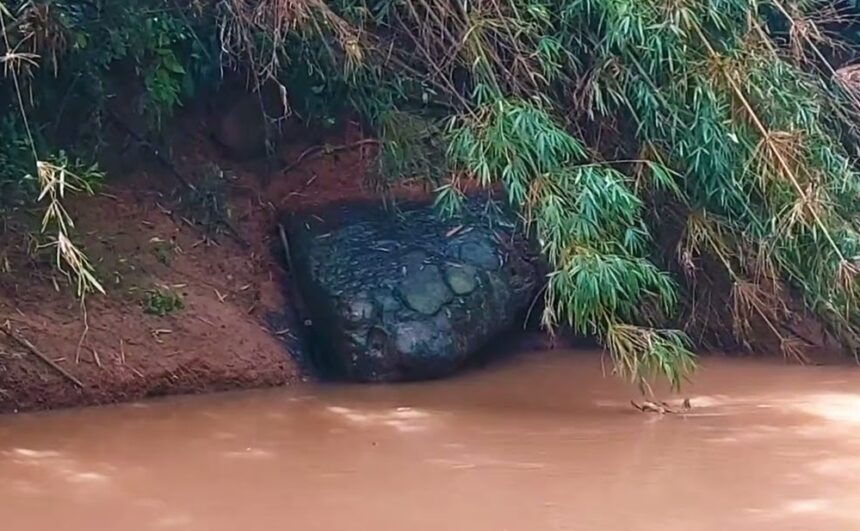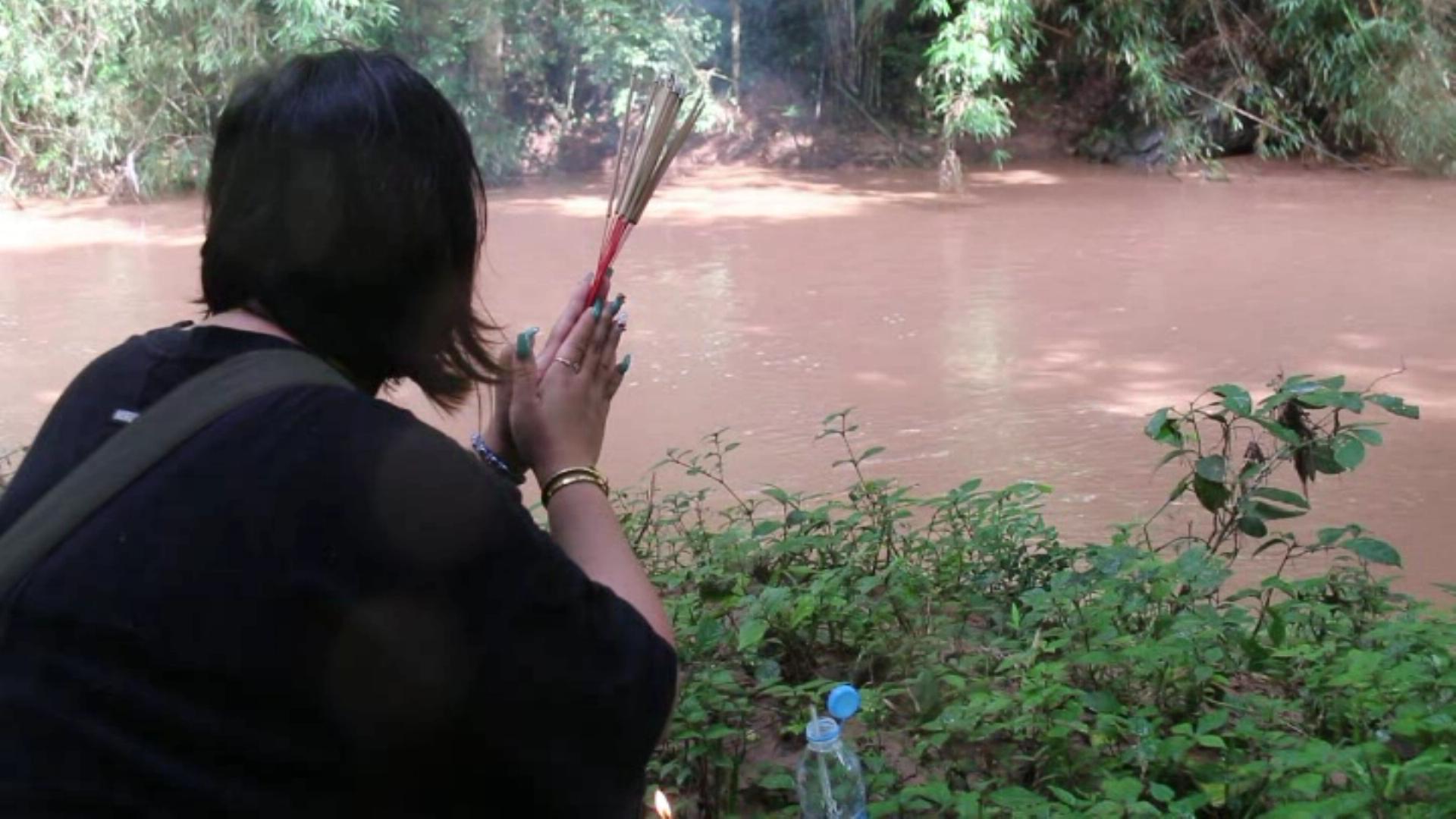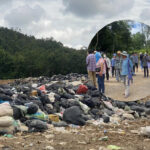PHETCHABUN – In the misty hills of Phetchabun Province, where the Nam Khek River winds past jungle and cliff, a strange rock has stolen the show. Locals call it the Giant Snake Rock. The boulder, scored with grooves that residents say resemble scales, has turned a quiet riverside track into a steady pilgrimage route.
In a matter of weeks, visitors have arrived with incense and flowers, asking for luck, love, and winning numbers. A small online rumour became a wall of smoke, soft chanting, and hopeful faces.
The story behind the find feels like folklore. On 25 September, a local hiker, Somchai Boonmee, went for a solo walk near Khao Kho National Park and came across the rock beside the river in Tambon Khek Noi, Khao Kho District. The site sits near the line between Phetchabun and Phitsanulok.
The snake rock stretches more than 10 metres and rises several feet. Its worn surface locks into ridges that look like the coils of a naga, the serpent guardian honoured in Buddhist and Hindu belief. Somchai later said he froze when he saw it. He felt as if a serpent head of Naga, complete with eyes and fangs shaped by the river, stared back at him.
Snake Rock Video Goes Viral
The internet did the rest. Instagram and Facebook videos from “Good Night Hmong Thai” spread more images, with many comparing the rock to the Naga Cave in Bueng Kan Province. Hashtags such as #SnakeRockPhetchabun and #NagaBlessing trended across Thailand.
By early October, Highway 12 between Phitsanulok and Lom Sak saw cars parked nose to nose. People stepped out with marigold garlands, bananas, and bottles of red Fanta, which are common offerings for naga spirits.
For many, the rock is not just a curiosity. It feels sacred. In Thai belief, naga spirits guard rivers and can bring fortune. Stories tell of naga kings shaping great waterways, and similar tales now swirl around the Nam Khek, a tributary of the Wang Thong, known for its whirlpools and rapids.
Pimol Srisuk, 62, walks the muddy 1.2‑kilometre path each day to tend a small shrine by the boulder. Fresh flowers, bai si towers made of rice, and strips of coloured cloth now gather at its base. Pimol, a lifelong rice farmer, lights incense and tells visitors she prayed for her son’s health and saw good news from the doctor soon after. She says the naga hears those who come in good faith.
The surge has changed life in Khek Noi, a village of fewer than 2,000 people tucked in the Phetchabun mountains. A sleepy fishing spot has turned into a lively market. Stalls now sell moo yang skewers, sticky rice, and cold coconut water to soothe tired walkers caked in red clay.
Vendor Noi Chaisuwan, 45, says her takings have tripled compared with the rainy season rafting period. Rubber boots, rented for 50 baht, have become essential for the slick riverside track. Cheawalit Chai Kaew, 28, credits a serpent dream for his recent lottery win.
He drove overnight from Bangkok to give thanks, carrying a tall bai si pyramid made of rice and sweets. He knelt, lit incense, and read curls of smoke as the numbers 5-2-9, ready for the next draw.
Revellers Flock to Pray at The Giant Snake Rock
Visitors now arrive from far and wide. Weekend road-trippers from Bangkok pack SUVs and shed skepticism once they reach the water’s edge. Families from Khon Kaen and Nakhon Ratchasima come with children holding toy snakes. Even overseas travellers have joined the crowd.
A Swedish backpacker named Lars said he is not religious, yet the place feels alive. The appeal lies in its simplicity. There is no temple wall or formal rite. People wade to the rock, speak their wishes to a river guardian, and let the current carry their hope.
Geologists see the scene in a different light. Asst. Prof. Jessada Denduangboripant of Chulalongkorn University says the boulder likely formed through “sun cracks”, which are natural fractures from heat expansion in ancient sedimentary rock, made deeper by long water erosion.
He calls it a fine case of pareidolia, where the brain spots familiar shapes in random patterns.
No fossil serpent hides here, only the work of stone and time. The nearby whirlpools are typical eddies caused by the river’s bend. Some locals push back at this view. A village elder, also named Somchai, says science can describe the shell while faith speaks to the spirit within.
Crowds now top 1,000 people a day, according to park staff, and pressure on the riverbank has raised alarm. Foot traffic cuts into the soil and speeds up erosion. Rubbish also threatens the area’s wildlife.
Officials from Khao Kho National Park plan to set rules that protect the site without dampening its draw. The early list includes set paths, more bins, and timed entry to spread the flow. Park chief Supachai Thongkham says the place is a gift from the land, so visitors should honour it and leave it as they found it.
For now, the Giant Snake Rock sits by the Nam Khek and keeps its secrets. In a country still facing economic strain and the long tail of the pandemic, the stone offers comfort. It reminds people that fortune bends and turns, yet often finds those who look for it.
At dusk, when the peaks fade into mist, new pilgrims arrive with phone lights and fresh incense. The serpent, many believe, still has messages to share.















